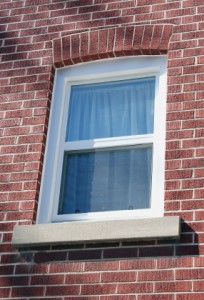Statistically, windows are to blame for roughly 13% of air leakage in a house. (1) Any uncontrolled air movement in or out of a house results in more greenhouse gas emissions – either from the need to increase heating to warm the cold air that has infiltrated the house, or in summer the need to cool off the warm air that has entered. (2)
New windows
 When buying new windows, look for the ENERGY STAR symbol to identify the most energy-efficient products for your climatic zone. ENERGY STAR-qualified products will save money by reducing overall annual energy costs by up to 12%.
When buying new windows, look for the ENERGY STAR symbol to identify the most energy-efficient products for your climatic zone. ENERGY STAR-qualified products will save money by reducing overall annual energy costs by up to 12%.
Only the most efficient windows will have the ENERGY STAR logos, but all windows come with an Energy Rating based on solar heat gains; heat loss through frames, spacer and glass; and air leakage heat loss. The higher the energy rating the better. (3)
There are a number of other factors to consider when buying and installing new windows to achieve optimal energy efficiency in your house:
- Window placement – Avoid large areas of west-facing glass. Overheating in summer is most likely to come from windows that face west. South-facing windows actually take in less heat in summer than west-facing windows because the sun’s high elevation means little sun actually strikes them. Awnings or an eave overhang can block what little sun does reach the window. In winter, in contrast, the sun’s lower elevation means more sunlight will reach south-facing windows and help warm the interior. These solar gains can decrease heating costs.
- Window size – Installing a few large windows is a better choice than putting in many small ones, since larger windows reduce the proportion of frame to glazing, which generally means better window performance.
- Window Style – Operable windows allow more air leakage than fixed windows. If you choose windows that open, casement windows have the best seal and lowest air leakage for operable windows. (Casement windows are hinged on one side and swing open.) Horizontal sliders are the least efficient.
- Glazing – Triple-glazed windows are more energy efficient than double-glazed windows. However, a low-e (low emissivity) double-glazed window provides similar insulation value as a triple-glazed window, but costs and weighs less. They allow sunlight to pass through, but keep heat from escaping. Another option is to choose an inert gas fill, in which argon or krypton replaces air between the sealed panes of glass. Inert gases have higher insulating value than air.
- Frames – The best insulating frames are wood, clad wood, vinyl, or fibreglass. Aluminum frames do a poor job at insulating. (4) The best energy performance in window frames has been achieved using a fibreglass frame with foam insulation in the frame cavities. (5)
Existing windows
There are four basic options for improving the energy efficiency of windows in an existing home:
- Repair – You can improve the window’s performance by annually cleaning the window’s hardware, tightening screws, lubricating moving parts and replacing cracked glazing.
- Retrofit – You can go one step further by testing your windows for airtightness (hold a tissue or piece of plastic near the window frame on a cold or windy day and watch for it to flutter) and then sealing the air leaks. Caulking is used for fixed joints, weather stripping for moving parts on an operable window.
- Reglaze – You can add layers of glazing by installing interior or exterior storm windows. You may also improve draughty windows temporarily by adding a heat-shrink plastic film to them for winter.
- Replace – Buy new windows. If all of the original windows and doors in an average older home were replaced by high efficiency windows and doors, the household energy consumption would be reduced by about 7% which would save three-quarters of a tonne of greenhouse gas emissions each year. (6)




